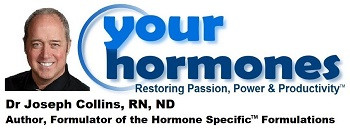
Anticancer Actions of Specific Herbs for Low Estrogen Symptoms by Joseph J Collins, RN, ND
Wouldn’t it be great to get rid of hot flashes, night sweats, insomnia, fatigue, weight gain, memory changes, and other menopause symptoms without increasing your risks of cancers?
That can be accomplished by using specific herbs that will decrease specific estrogen deficiency symptoms, without raising estrogen levels.
Hot flashes, night sweats, insomnia, fatigue, weight gain and memory changes are common symptoms of low estrogen function that occur in menopause and other conditions with low estrogen. Those symptoms may cause women to seek hormone therapies including estrogen replacement therapies. However, all estrogen replacement therapies (including bioidentical hormone replacement therapies) may increase the risk of developing estrogen sensitive cancers.
Symptoms of low estrogen can be significantly decreased and in many cases totally eliminated by using the proper combination of estrogen specific herbs. These herbs, with a healthy diet can be so effective in relieving estrogen deficiency symptoms that you may not even need estrogen replacement therapy!
But more than that, each of these herbs have actually been shown to have anticancer actions!
Non-hormonal treatments such as diet and herbs are useful alternatives in patients with a history of breast cancer [1]. In fact, the anticancer actions of these herbs are so impressive that can be an important part of any program to support healthy aging and decrease cancer risk.
Cancer risks can also be decreased by eating certain whole foods rich in phytoestrogens that can also help decrease estrogen deficiency symptoms. And, by decreasing estrogen deficiency symptoms, those foods may make it easier to lower the dosage of estrogen replacement therapy, which can lower the cancer risks associated with any type of estrogen replacement therapy. These foods rich in phytoestrogens include many fruits, vegetables, grains, seeds and legumes, as well as many culinary herbs and spices.
The therapeutic herbs that we will be looking at all have the ability to decrease specific estrogen deficiency symptoms without increasing the risk of cancer. These specific herbs do not raise estrogen levels. In fact, published literature shows these herbs will actually decrease cancer risks, and may have anti-cancer actions. These herbs include Pueraria montana & Pueraria lobate, Trifolium pretense,Bacopa monnieri, Centella asiatica, Humulus lupulus, Angelica sinensis, Schizandra chinensis, Salvia officinalis and Cimicifuga racemose.
Those specific herbs were chosen to treat symptoms of low estrogen because they are able to treat those symptoms without increasing estrogen levels. There are other herbs that can increase estrogen levels, and I use them in the TestoQuench™ for Women formulation to help control excessive testosterone, but they are not used in the formulation I developed to decrease symptoms of low estrogen.
Understanding Anti-Cancer Words
Before we look at the anticancer actions of each of these specific herbs we need to know how cancer cells act, and how specific herbs work against cancer cells.
Cancer cells are dangerous because cancer cells grow and divide too quickly. Growth and division of cells is called proliferation. So, we want herbs that have antiproliferative actions, herbs that inhibit proliferation.
Normally, all cells have a normal life cycle and then they are programmed to die. This programmed cell death is called apoptosis. However, cancer cells can have abnormally long life cycles, allowing them to keep growing and dividing. So, we want herbs that increase apoptosis and cause the cells to die.
Anticancer and anticarcinogenic actions are pretty obvious actions – the herb stops cancer. We also want herbs that have antitumour activity and that inhibit tumorigenesis.
Now let's look at the specific anticancer actions of each of the herbs that I use in a Hormone Specific™ Formulation to decrease the symptoms of low estrogen without raising estrogen levels.
Next: Learn about Pueraria montana and Pueraria lobate
References
To review the PubMed listing of any reference, go to www.ncbi.nlm.nih.gov/PubMed/ and enter the PubMed PMID number at the end of the reference.
[1] Drewe J, Bucher KA, Zahner C. A systematic review of non-hormonal treatments of vasomotor symptoms in climacteric and cancer patients. Springerplus. 2015 Feb 10;4:65. PubMed PMID: 25713759.
